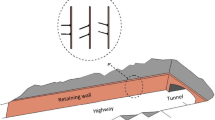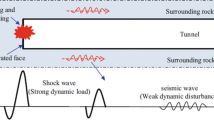Abstract
The deformation characteristics of rock slopes with weak structural plane are governed by the mechanical properties and geometrical distribution of the structural plane. In particular, the weak structural planes can be excavated and disturbed in the tunnel excavation process, which makes the deformation characteristics complex. Long-term monitoring using a multi-point displacement meter was used to analyse the deformation characteristics of a rock slope with weak bedding structural planes under tunnel excavation. The monitoring results show that the displacement increases with increasing excavation time and tends to eventually stabilize in the tunnel excavation process with three fast movements. The deformation is mainly within the depth of 0–10 m from the slope surface. The excavation blasting affects the slope deformation above structural plane I, and there is no obvious correlation between rainfall and the slope deformation. The excavation distance also affects the slope deformation: first, the slope deformation has a sudden increase when the excavation face arrives at a certain section; then, it further increases when the excavation face continues to increase; and finally, the deformation decreases and tends to gradually stabilize when the excavation face is far away from the section. Moreover, the weak structural plane has a great impact on the slope deformation, particularly at structural plane I. The failure mode of the slope under an external load is also discussed: the sliding body first slides along weak structural plane I and subsequently slides along structural plane II when the external load further increases.











Similar content being viewed by others
References
Admassu Y, Shakoor A, Wells NA (2012) Evaluating selected factors affecting the depth of undercutting in rocks subject to differential weathering. Eng Geol 124(1):1–11
Bonilla-Sierra V, Scholtès L, Donzé F et al (2015a) Rock slope stability analysis using photogrammetric data and DFN–DEM modelling. Acta Geotech 10(4):497–511
Bonilla-Sierra V, Scholtè L, Donzé F et al (2015b) Dem analysis of rock bridges and the contribution to rock slope stability in the case of translational sliding failures. Int J Rock Mech Min Sci 80(2):67–78
Cundall PA (1971) A computer model for simulating progressive large scale movements in blocky rock systems. Proceedings of the Symposium of the International Society of Rock Mechanics Vol. 1. Nancy, France, pp 129–136
Dong HK, Balasubramaniam A (2013) Determination of joint roughness coefficient (JRC) for slope stability analysis: a case study from the Gold Coast area, Australia. Landslides 10(5):657–664
Dong HK, Gratchev I, Balasubramaniam A (2015) Back analysis of a natural jointed rock slope based on the photogrammetry method. Landslides 12(1):147–154
Fan G, Zhang J, Wu J, Yan K (2016) Dynamic response and dynamic failure mode of a weak intercalated rock slope using a shaking table. Rock Mech Rock Eng 49(8):1–14
Goodman RE (1976) Methods of geological engineering in discontinuous rocks, First edn. West, New York, p 472
Huang R, Zhao J, Ju N, Li G, Lee ML, Li Y (2013) Analysis of an anti-dip landslide triggered by the 2008 Wenchuan earthquake in China. Nat Hazards 68(2):1021–1039
Ivanov ID (2003) Simple procedure for quantification of the gravitational stress field in fractured hard rock massifs. Eng Geol 68(3–4):397–400
Jiang T, Liu Y, Ma J (2013) Time history response analysis of jointed rock slope under seismic loads. Chin J Rock Mech Eng 32:3938–3944
Jiang M, Jiang T, Crosta GB, Shi, Z., Chen H, Zhang N (2015) Modeling failure of jointed rock slope with two main joint sets using a novel DEM bond contact model. Eng Geol 193:79–96
Kontogianni VA, Stiros SC (2005) Induced deformation during tunnel excavation: evidence from geodetic monitoring. Eng Geol 79(1–2):115–126
Kuznetsov SV, Trofimov VA (2007) Deformation of a rock mass during excavation of a flat sheet-like hard mineral deposit. J Min Sci 43(4):341–360
Liu Y, Li H, Xiao K, Li J, Xia X, Liu B (2014a) Seismic stability analysis of a layered rock slope. Comput Geotech 55(1):474–481
Liu HX, Xu Q, Li YR (2014b) Effect of lithology and structure on seismic response of steep slope in a shaking table test. J Mt Sci 11(2):371–383
Massey CI, Petley DN, Mcsaveney MJ (2013) Patterns of movement in reactivated landslides. Eng Geol 159(12):1–19
Mavrouli O, Corominas J (2010) Vulnerability of simple reinforced concrete buildings to damage by rockfalls. Landslides 7(2):169–180
Mirenkov VE (2014) Zonal disintegration of rock mass around an underground excavation. J Min Sci 50(1):33–37
Moon J, Fernandez G (2010) Effect of excavation-induced groundwater level drawdown on tunnel inflow in a jointed rock mass. Eng Geol 110(3–4):33–42
Ozbay A, Cabalar AF (2015) FEM and LEM stability analyses of the fatal landslides at Çöllolar open-cast lignite mine in Elbistan, Turkey. Landslides 12(1):155–163
Schwer LE, Lindberg HE (1992) A finite element slideline approach for calculating tunnel response in jointed rock. Int J Numer Anal Methods Geomech 16(7):529–540
Shi G (1988) Discontinuous deformation analysis—a new numerical model for the statics and dynamics of block systems. Phd Dissertation, Department of Civil Engineering, University of California at Berkeley, USA
Shi G, Goodman RE (1988) Discontinuous deformation analysis—a new method for computing stress, strain and sliding of block systems. In: Proceedings of 29th U.S. symposium rock mechanics, Minneapolis, pp 381–393
Song Y, Huang D, Cen D (2016) Numerical modeling of the 2008 Wenchuan earthquake-triggered Daguangbao landslide using a velocity and displacement dependent friction law. Eng Geol 215:50–68
Song D, Feng X, Wang Z et al (2017) Using near-real-time monitoring of landslide deformation to interpret hydrological triggers in Jiudian Gorge Reservoir. Indian J of Geomarine Sci 46(11):20182–22190
Stead D, Wolter A (2015) A critical review of rock slope failure mechanisms: the importance of structural geology. J Struct Geol 74(3):1–23
Toki K, Miura F, Oguni Y (2010) Dynamic slope stability analyses with a non-linear finite element method. Earthq Eng Struct Dyn 13(2):151–171
Tokiwa T, Tsusaka K, Aoyagi K (2017) Fracture characterization and rock mass damage induced by different excavation methods in the Horonobe URL of Japan. Int J Civ Eng 16(2):1–11
Troncone A, Conte E, Donato A (2014) Two and three-dimensional numerical analysis of the progressive failure that occurred in an excavation-induced landslide. Eng Geol 183(3):265–275
Tuǧrul A (1998) The application of rock mass classification systems to underground excavation in weak limestone, Atatürk dam, Turkey. Eng Geol 50(3):337–345
Wang JJ, Liang Y, Zhang HP et al (2013) A loess landslide induced by excavation and rainfall. Landslides 11(1):141–152
Wang JJ, Zhao TL, Chai HJ, Tang SC (2016) Failure of a rock slope 16.5 years after excavation in repeated strata of sandstone and mudstone. Environ Earth Sci 75(22):1458
Wu JH, Ohnishi Y, Shi GH, Nishiyama S (2005) Theory of three-dimensional discontinuous deformation analysis and its application to a slope toppling at Amatoribashi, Japan. Int J Geomech 5(3):179–195
Xia M, Ren GM, Ma XL (2013) Deformation and mechanism of landslide influenced by the effects of reservoir water and rainfall, Three Gorges, China. Nat Hazards 68(2):467–482
Xu Q, Dong X (2012) Characteristics and formation mechanism of a catastrophic rainfall-induced rock avalanche–mud flow in Sichuan, China, 2010. Landslides 9(1):143–154
Xu BT, Yan CH (2014) An experimental study of the mechanical behavior of a weak intercalated layer. Rock Mech Rock Eng 47(2):791–798
Xu DS, Yin JH (2016) Analysis of excavation induced stress distributions of gfrp anchors in a soil slope using distributed fiber optic sensors. Eng Geol 213:55–63
Yin Y, Wang H, Gao Y, Li X (2010) Real-time monitoring and early warning of landslides at relocated Wushan Town, the Three Gorges Reservoir, China. Landslides 7(3):339–349
Yoshizawa N, Hosokawa Y (2011) Analysis of rotational slide using surveyed data of surface displacement in landslide area. Landslides 23(4):13–23
Zhang M, Nie L, Xu Y, Dai S (2015) A thrust load-caused landslide triggered by excavation of the slope toe: a case study of the Chaancun landslide in Dalian city, China. Arab J Geosci 8(9):6555–6565
Zhou JW, Jiao MY, Xing HG, Yang XG, Yang YC (2017) A reliability analysis method for rock slope controlled by weak structural surface. Geosci J 21(3):453–467
Acknowledgments
The authors warmly thank Chengdu University of Technology and Anhui Transportation Holding Group Co., Ltd. of China for its continuous support, which has helped to provide the precious monitoring data. We would like to express our gratitude to the editors and reviewers for their constructive and helpful review comments.
Funding
This work is financially supported by the National Natural Science Foundation of China (41702311).
Author information
Authors and Affiliations
Corresponding author
Rights and permissions
About this article
Cite this article
Song, D., Chen, J. & Cai, J. Deformation monitoring of rock slope with weak bedding structural plane subject to tunnel excavation. Arab J Geosci 11, 251 (2018). https://doi.org/10.1007/s12517-018-3602-7
Received:
Accepted:
Published:
DOI: https://doi.org/10.1007/s12517-018-3602-7




